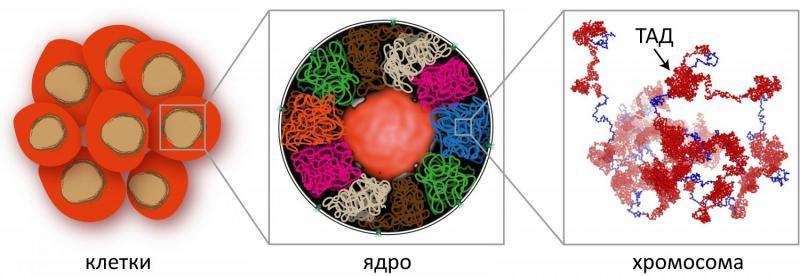New mechanisms of self-organization in living cells

Chromosomes are structures inside cell nuclei that carry a large part of the genetic information and are responsible for its storage, transfer and implementation. Chromosomes are formed from a very long DNA molecule—a double chain of a plurality of genes. Given that the diameter of the cell nucleus is usually around hundredth of a millimeter or even less, while the total length of DNA composing the human genome is about two meters, it is clear that DNA must be packaged very tightly.
DNA-protein fibril forms visible mitotic chromosomes only during cell division. But in between the divisions, DNA is not just floating in the cell nucleus, In order to avoid becoming tangled or broken, it is wound on special proteins called histones, like long, thin strands of thread on a spool, and is then folded in such a way that some sections of the DNA strand are close to each other and can interact to form compact aggregates. These compact regions are called "topologically associated domains," or TADs. Regions located between the TADs ("inter-TADs"), by contrast, are characterized by a low level of interaction.
A group of Russian researchers, led by Sergei Razin of Lomonosov Moscow State University, studied how filamentous DNA-protein fibrils of chromatin are stacked in three-dimensional structures—TADs and inter-TADs. The results of the research have been published in Genome Research, and have also been mentioned in the Research Highlights section of the current issue of Nature Review Genetics.
"Spools" "hustle" - genes change
"Previously, several authors have demonstrated that the genomes of mammals and fruit flies are organized into compact topologically associated domains—TADs separated by some border areas," said Razin. "Yet the nature of these border areas has remained unclear. Most authors believe that the very existence of these boundaries between compact domains is determined by the presence of special "dividing" genomic elements—insulators. But no one could explain the mechanism of their action. We have demonstrated that TADs are separated by active regions of the genome containing housekeeping genes that work in all types of cells. Features of chromatin in working genes are sufficient to explain why such a chromatin simply can't be stowed in compact TADs."
Russian scientists were able to show how the DNA-protein fibril itself fits into the three-dimensional structure. This is a vivid demonstration of the mechanisms of self-organization in living cells. It is this conceptual component of the work that resonated with researchers all over the world.
Genes turn on and off—diseases emerge
"In Russia we had have no such breakthrough works in genomics for many years. This became possible due to the interdisciplinary nature of the group of authors from biology, bioinformatics, and physics. Computer simulation that was fundamentally important to confirm the findings has become possible due to the presence of supercomputer Lomonosov at MSU," says Razin.
Findings made by Russian researchers may provide the basis for important practical developments. Scientists have good reason to believe that TADs are also regulatory domains in which enhancers (small sections of DNA that increase the expression of genes) can activate a variety of tissue-specific genes. Thus, the association of TADs as a result of chromosomal rearrangements or their separation can lead to changes in the spectrum of genes that are activated by any given enhancer, and this may be the cause of various diseases.
A new approach to old diseases
According to Razin, the knowledge of the mechanisms of formation of these diseases will enable science-based strategies for their treatment. Currently, many pharmaceutical companies are already actively engaged in the development of so-called epigenetic drugs that can, for example, make the cancer cells lose the ability to multiply uncontrollably. However, this work is currently being conducted largely at random, by analyzing the effects that various compounds have on the work of epigenetic mechanisms. In order to make searching for such drugs more meaningful, one must understand how epigenetic control of gene transcription works. It is currently clear that these systems affect the packaging of DNA inside chromatin. Thus, the disclosure of principles of the three-dimensional organization of chromatin fibrils is a prerequisite for understanding the mechanisms of epigenetic systems and, consequently, developing strategies of targeted intervention into the operation of these systems.
More information: Joana Osório, Moving a TAD closer to unravelling chromosome architecture. Nature Reviews Genetics (2015) DOI: 10.1038/nrg.2015.7
Sergey V. Ulianov et al. Active chromatin and transcription play a key role in chromosome partitioning into topologically associating domains, Genome Research (2015). DOI: 10.1101/gr.196006.115
Journal information: Genome Research
Provided by Lomonosov Moscow State University



















